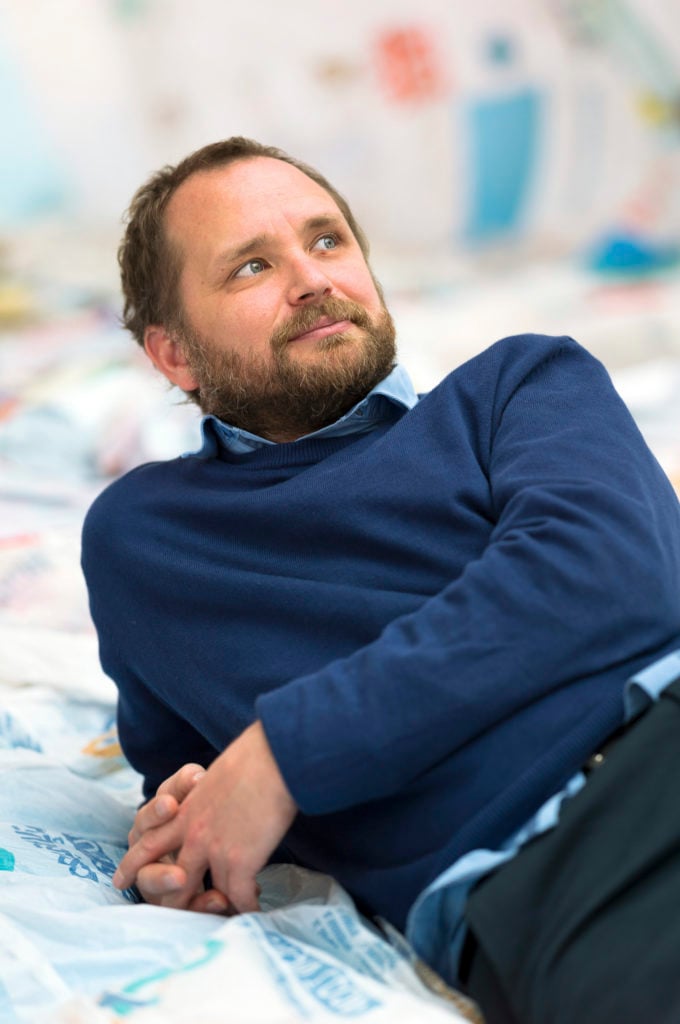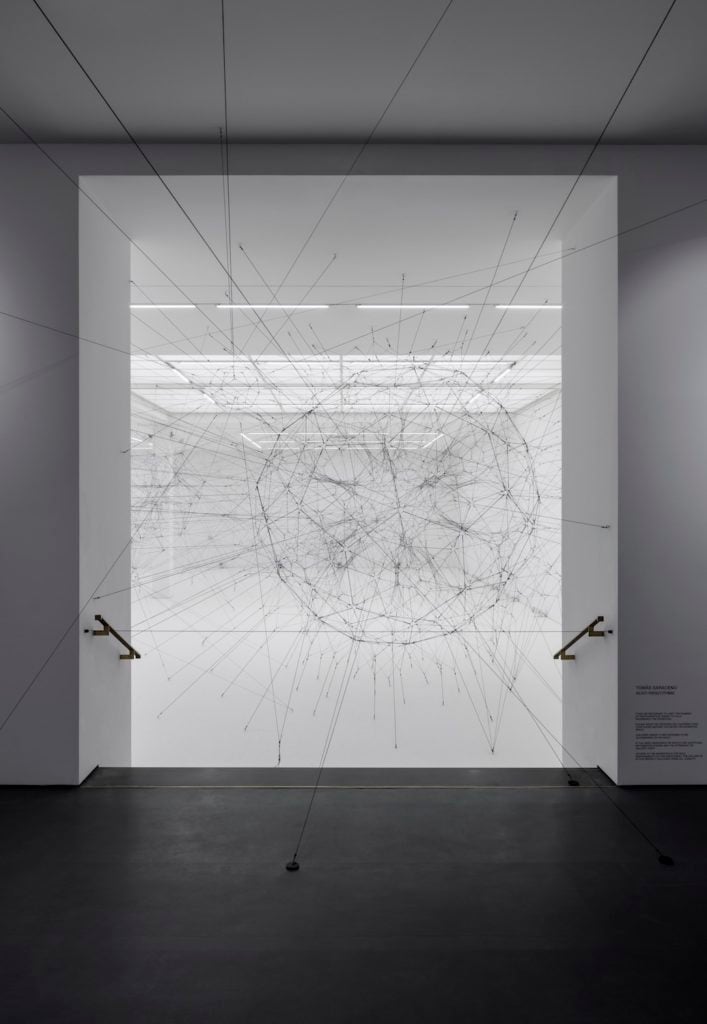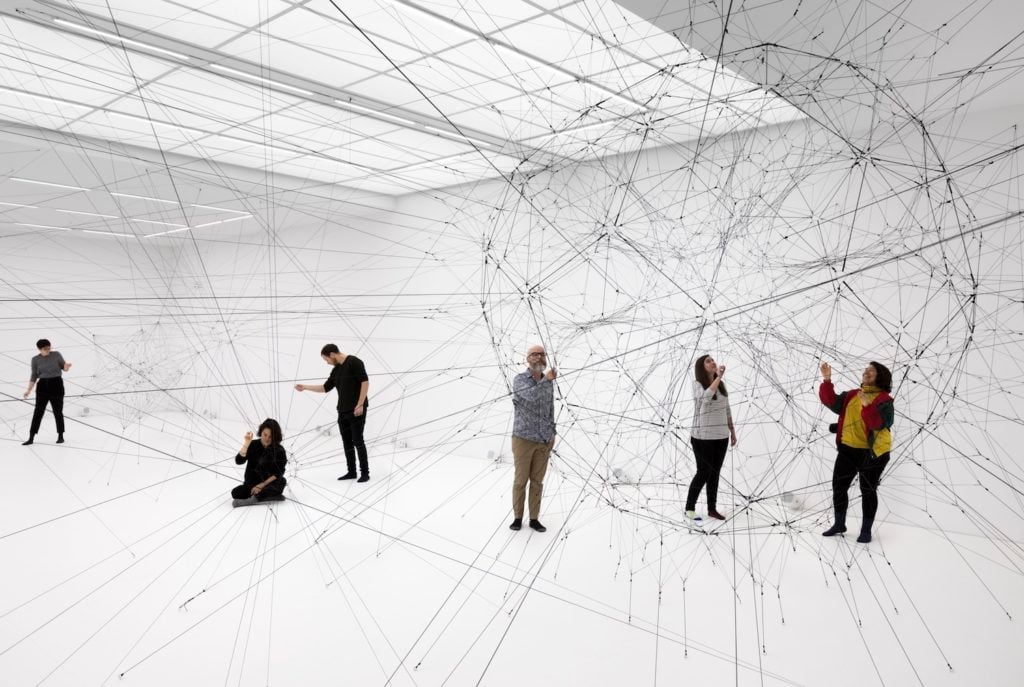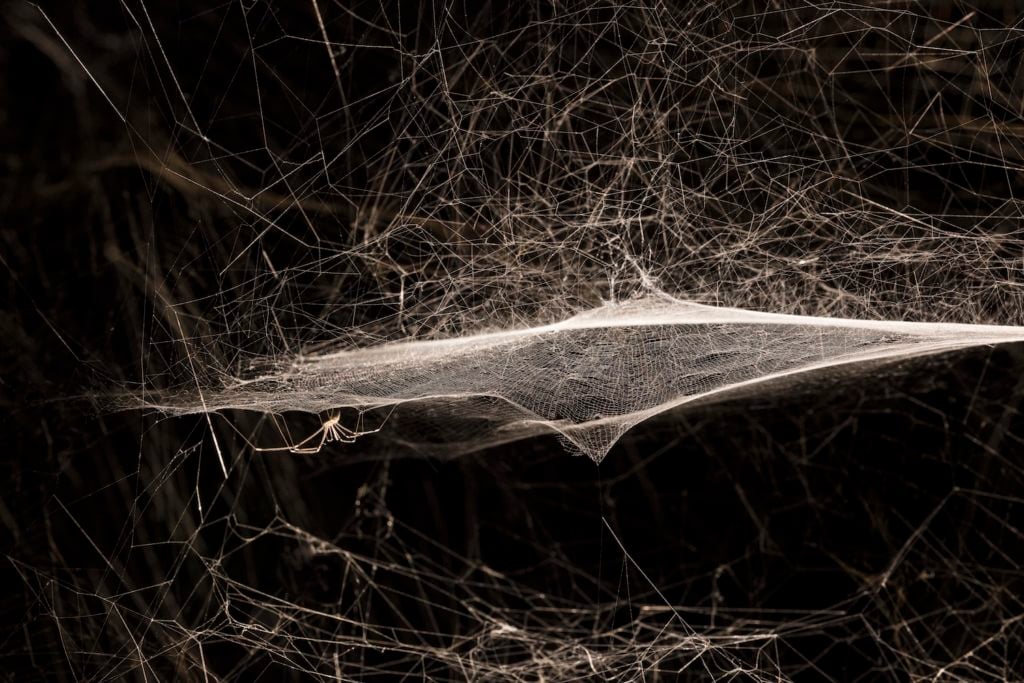People
Tomás Saraceno, Brainy Spider-Man of the Art World, Talks Arachnids—and Denies He Is Trying ‘to Capture and Eat Berlin’s Art Scene’
The environmentally conscious artist's entire show at Esther Schipper in Berlin packs up into one box.

The environmentally conscious artist's entire show at Esther Schipper in Berlin packs up into one box.

Kimberly Bradley

My daughter calls Tomás Saraceno “the spider man who’s not Spider-Man.” Over and over, I’ve written profiles of and done interviews with the Argentinian, Berlin-based artist, returning home each time to show my 10-year-old my newest smartphone images of glistening spider webs that the artist researches, preserves, and exhibits, as well as the exotic spiders that spin them. She’s always fascinated and a little scared (right now she prefers snakes to spiders).
“I, of course, like the spiders, but I like their webs better,” Saraceno told me at a party in Berlin a few weeks ago. As a metaphor, the web is the ultimate referent to Saraceno’s practice. Many of his works occur as weblike objects: early pieces, like his many iterations of “Cloud Cities,” are intricate, quasi-utopian architectures suspended high in the air from cables; more recent works have included real spider webs in two or three dimensions.
But this son of two scientists is as much about the increasingly dense web of knowledge that interconnects his multiple lines of inquiry (astrophysics, architecture, and arachnology are just the beginning). A growing network of collaborators and researchers (human and nonhuman) is involved in this voracious research, so it’s also about a collective consciousness that, if Saraceno’s lofty visions came to fruition, could be capable of transcending the most dire of humanity’s problems.
“Algo-r(h)i(y)thms,” the artist’s new exhibition at Esther Schipper in Berlin, is another representation of Saraceno’s complex web. All 300 square meters (3230 square feet) of the blazingly white exhibition space is filled with a floor-to-ceiling network of black cording arranged in clusters of varying sizes that are attached to each other as well as the ceiling, walls, and floor.
Viewers walk into the spider web-meets-galaxy-meets-Buckminster Fuller work, which is beautiful, disarming, and multi-sensory. When plucked or rubbed, miked cords make sounds that reverberate throughout the web and the room. The frequencies of the smaller clusters are calibrated to match those of an Argiope keyserlingi spider’s courtship signal; the larger ones refer to clouds in a distant galaxy. The sonic effect is ethereal, sometimes sounding digital and other times approximating a violin or piano string.

Tomás Saraceno “Algo-r(h)i(y)thms,” Esther Schipper, Berlin, 2019. Courtesy the artist and Esther Schipper, Berlin. Photo © Andrea Rossetti
On the show’s opening day, Saraceno laughed as he met me in the gallery for yet another interview. Me again. I feel like I’ve stalked him for two years, appearing repeatedly in the multi-story factory Berlin studio that he’s occupied since 2013 (he came to Germany to study architecture, then art), each time meeting yet a few more of his 80-odd employees and seeing what the spiders in the upstairs lab are spinning.
On a previous visit, I showed up in a remote rural field near the Polish border when he launched a group of outsize black triangular balloons—ongoing tests of solar-powered air flight and part of his “Aerocene” project (a foundation, a community, and part of an idea that we all might somehow live in the sky or fly without fossil fuels). I’ve come to see him at galleries and museums mid-installation—this one took more than two weeks—and enjoyed witnessing the outcomes of large-scale exhibitions like the vast “On Air” show at Paris’s Palais de Tokyo last year.
Yet truly following the man is unrealistic: Beyond showing extensively in biennials and institutions on all continents, he also meets with government ministers about fossil-free transportation, does TED talks, orchestrates concerts between musicians and arachnids, and disappears into remote regions with shamans and healers. In the past, he’s worked with some of the world’s more esteemed scientific institutions, including NASA, MIT, and Max-Planck Institute. His smartphone schedule is a mess of highlighter colors and appointments. His mind is somewhere in the metaphorical clouds, most of the time.

Tomás Saraceno “Algo-r(h)i(y)thms,” Esther Schipper, Berlin, 2019. Courtesy the artist and Esther Schipper, Berlin. Photo © Andrea Rossetti
Saraceno hands me an instruction manual to the show before we enter the gallery in felt slippers. The sheet explains how spiders tap and pluck their webs to communicate and serves as inspiration for viewers to “play” what they’re seeing. The installation is meant to be one instrument: “Like people on the same piano, not like an orchestra,” Saraceno says. It’s an embodiment of the notion that everything from the cosmos to the tiniest invertebrate is connected.
He explains spider behavior, which is solely based on vibrational sensing (spiders are both blind and deaf): Much behavior seems deviant to mammalian standards. There are spiders who mimic the courtship vibration only to eat the spider they’ve just courted (seems oddly familiar, on some level). Other spiders eat their mothers when her body starts drumming a signal (a matricidal dinner bell of sorts).
“So this installation is supposed to capture and eat Berlin’s art scene?” I ask. “I’m not a black widow,” he says, with his signature raspy laugh. For all our humorous banter, the conversation reveals the extensive research and cross-disciplinary thinking that goes into these works. But at the same time, they are crowd-pleasers: immersive and just fun. It’s not quite “Big Fun Art” (a coinage by Artnet News critic Ben Davis); rather, Saraceno seems to use accessibility as to lure the viewer into engaging with far more complex subjects.
There is something of a mad scientist vibe to Saraceno, who every time I visit the studio, enthusiastically shows me everything new he and his multinational teams are working on (last time it was the Arachnomancy app, on view at Ralph Rugoff’s main exhibition at this year’s Venice Biennale).
Palais de Tokyo’s “On Air” curator Rebecca Lamarche-Vadel has likened Seraceno’s polymathy to that of Leonardo da Vinci. Lately, though, Saraceno is not only departing from the visual in favor of sound, but is also delving into instinct and intuition. In an effort to access dormant or nonhuman knowledge and understand subtle sensory input (as well as mentally manage a brutal travel schedule and a midsize company), he has been trying new things. He’s currently into Transcendental Meditation, will soon travel to Cameroon for a divination ceremony, and will return to the jungle in Argentina with a Colombian shaman to better understand natural sound.

Tomás Saraceno Webs of At-tent(s)ion, 2018 Exhibition view of ON AIR, Carte Blanche to Tomás Saraceno, Palais de Tokyo, Paris, 2018. Curated by Rebecca Lamarche-Vadel. Courtesy the artist and Esther Schipper, Berlin. Photo © Andrea Rossetti
On a more practical level, Saraceno’s studio recently audited its energy use and found that more than 50 percent fell to art transport. The team is beginning to work around this. “This show packs down to one box!” Saraceno says of his entanglement at Esther Schipper.
To tweak his personal behavior amid a packed travel schedule, he has begun to take the train to London, has started biking to the studio when he can, and now wonders whether art can be shipped via one of his “Aerocene Explorer” balloons (or perhaps just be an “Aerocene” balloon, flying in during biennial openings).
Still, Saraceno is not preachy. “One of the 10 points of advocacy is to never point fingers,” he says, mentioning the dangers of call-out culture or excessive self-criticism. “We have degrees of responsibility—response-ability,” he says, repeating something he’s told me before. “Our role—this gallery, myself, you—is actually very tiny. But if we change our habits, we’re less able to be manipulated for profit. We have to consciously locate ourselves. Try to see which alliances we have to build,” he says, becoming a little quiet. “I don’t know. It’s hard.”
Like my young daughter says, Saraceno the spider-man is not the superhero. He is an explorer of inner space and outer space, the creator of confluences, new forms of communication, and some contradictions. He exudes an idealism and optimism even in the midst of what’s called the Sixth Extinction. Most people leave conversations with him—or interactions with his art—feeling slightly different about the world and the creatures in it. Senses sharpen for just a little while, or forever. It’s one reason I keep coming back.
Weirdly, my daughter said yesterday that she was writing a story about a “flying city in the sky” in school, making me wonder if Saraceno’s alternate communication somehow made a direct pass to her through me. And I can’t bring myself to kill the spiders spinning webs at home anymore, because my home is their home, too. We are not alone.
Tomas Saraceno’s “Algo-r(h)i(y)thms” is on view at Esther Schipper in Berlin until December 21.